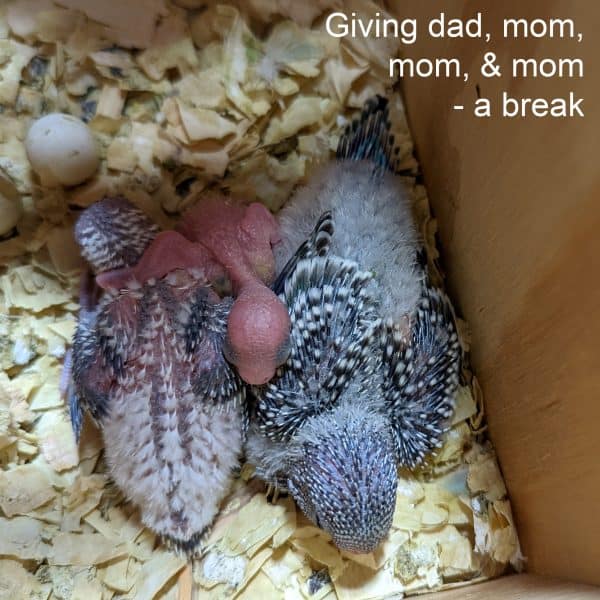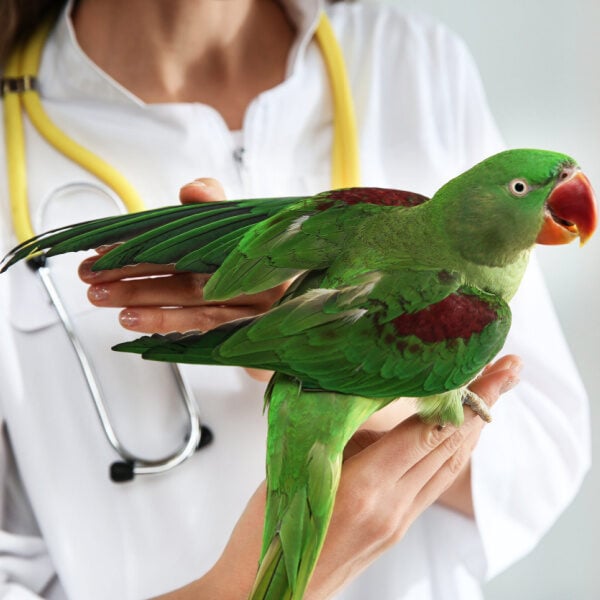
How Do I Hand Raise Baby Birds?
Last Updated on by Catherine Tobsing
Ask a breeder, a pet caregiver, and a bird, and you’ll receive 3 answers.
Having watched 3 juveniles go from egg to buzzing around my head, I certainly have my opinions.
Some of the challenges to hand-feeding baby birds:
- Grasping the beak
- Watery hand-feeding formula
- Timing
- Parental jealousy
- Flock jealousies
- Feeding other flock members
The entire dynamics of bird breeding in our recent case, budgie breeding, is much to do with the interactions of all the other birds in the cage.
In our scenario, we started with 7 females and 3 males all having resided in the same aviary for 2 to 6 years.

Our problems started when we decided to move the budgie aviary cage from the first floor between 4 large sunny double-hung windows and brought it upstairs with the other 3 small parrots in a room that has the majority of the lighting, coming from a dozen lamps and 9 birdcage lighting fixtures – give or take.
The change in lighting affected their hormones and the whole group got stirred up. For a bit, we thought we had a hen with eggs and were concerned about egg binding so we gave her a box but she didn’t need or use it, but 3 other hens did. Oh my, oh my.
Around 14 eggs in total were laid but we’re assuming multiple females. The three offspring clearly came from Waffles (see featured image – top).
We think Bagel may have been a contributing mom but with raging hormones also come epic jealousies.
We noticed 2 cuts on Bagel’s right face one afternoon.
We removed her from the main cage and placed her in the hospital cage after dabbing some antibiotic ointment on the small wounds.
After a week we tried to re-introduce her into the main aviary at least 3 times with the same result, she was immediately attacked by more than one of the other budgies.
For her safety, she has been rehomed with a single male in a new household and we hear they are getting along famously.
How this relates to hand feeding is that we discovered multiple females at least 2 that were helping sitting on the eggs and feeding the babies.
Although the household had 3 males, Waffles was the “hardest working bird in show business”.
He was always eating and then returning to the nest box for regurgitation redistribution to one of the moms or any of the babies.
When Bagel was in the hospital cage, Waffles would fly down to her to give her a taste of his special formula.
This went on until number 3 was fledged and you can still see Waffles opening the beaks of toddlers around the cage for a yummy sample.
As a footnote, we’ve always given our bird’s mixed veggies daily.
In that, the baby budgies were raised on veggies and they embraced the dark green kale mixture Catherine serves daily to our whole flock without question.
A few weeks into 3 hatchlings we had a talk about hand feeding when they were becoming old enough to pull.
We could have pulled them each at about 21-23 days and put them into a separate cage or warm container and then isolated them from the flock keeping them with human company only.
This would ensure that they would be better able to bond with us versus the cage-kept budgies we have now.
But that would be a good arrangement if we did not have the big cage of budgies as well. We knew that the babies if exposed, and introduced to the main cage would soon prefer their company over ours and we just decided to let them be what they are, cute little birds that enjoy the other birds.
Sure, there’s that whole “human/bird bonding thing” created with hand-feeding but we felt there are other ways post-fledging.
Out of all the budgies, Priscilla, one of the males came to us somewhat finger-tame but with the budgie aviary cage on the first level we didn’t let them out a lot with close proximity to the storefront door.
The upstairs is pretty perfect for free flight as there are no large exposed windows or big mirrors to fly into.
Twice daily I walk by the cage and offer a 2-inch sprig of millet to Priscilla who will gladly pick at it as long as I hold it up.
Yesterday for the first time #1 (young and dumb:-) came over for some hand-fed millet nummies.
Over time with millet being the “crack cocaine” of bird foods, everyone will come to my hand – to feed from eventually.
Personally, I don’t see the romance of setting an alarm for 4:00 AM feedings.
Catherine has observed over the years that often hand-feeding formula is mixed with too much water.
She usually offers a more viscous mix and then followed up with a pipette of fresh water at the end of the feeding sessions.
Shifting gears, have you ever seen a large hookbill with a too-long beak?
In some species like Eclectus parrots, a long beak can be attributed to a diet high in seed and low in protein.
Large birds like large macaws and cockatoos require a very precise “beak grip” when using the syringe.
The pressure applied to the beak with the fingers will ensure healthy beak growth.
The time to learn this is not with your first baby bird.
If it’s important for you to go through the hand-feeding process, I will advocate spending time with a reputable breeder for precise instructions, explanations, and practice – there are no do-overs.
Who needs blood pressure medication when you have this to do?
Author Profile
Latest entries
 The Traveling BirdJune 26, 2025Can You Name 5 Parrot Species That Are Living Wild in the USA?
The Traveling BirdJune 26, 2025Can You Name 5 Parrot Species That Are Living Wild in the USA? Bird BehaviorJune 26, 2025How is it Parrots Are Problem Solvers Social Animals and Even Use Tools?
Bird BehaviorJune 26, 2025How is it Parrots Are Problem Solvers Social Animals and Even Use Tools? Bird & Parrot AnatomyJune 25, 2025How a Tiny Chemical Modification Makes Parrots Nature’s Living Paintings
Bird & Parrot AnatomyJune 25, 2025How a Tiny Chemical Modification Makes Parrots Nature’s Living Paintings PigeonsJune 20, 2025How Do Parrots Thrive in Cities Outside Their Native Habitats?
PigeonsJune 20, 2025How Do Parrots Thrive in Cities Outside Their Native Habitats?


